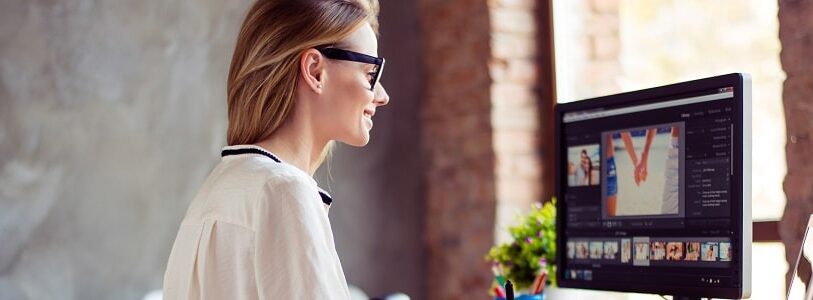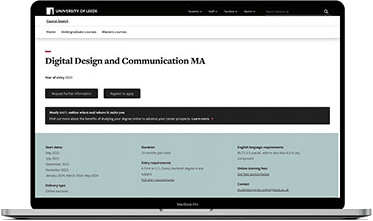What Can You Do with a Digital Design and Communication Degree?
Digital Design and Communication
In a post-pandemic world, talented employees with strong digital skills are in high demand across a variety of exciting and innovative creative industries. Whether you’re an existing design professional, looking to change roles, or new to the creative sector, now is a great time to develop your career in the digital design world.
But with so many roles on offer in the industry, you might be questioning whether digital design is a good career path.
In this blog, we’ll explore what you can do with a digital design degree, and clear up some of that confusion by exploring different creative careers, their typical salaries, and the key skills you’ll need to design your next career move.
Learn more about our Digital Design and Communication Masters1. Digital Design Lead
A Digital Design Lead is responsible for the overall design strategy of an online product or service and will inspire their team to create innovative digital solutions that address the challenges and opportunities of a client’s specific business needs.
Typical responsibilities include:
- Overseeing the design schedule to ensure the team’s deliverables are completed on time.
- Taking ownership of the project and working closely with clients to make sure all designs/solutions meet the requirements.
- Ensuring all relevant stakeholders are communicating effectively.
- Devising innovative solutions to complex problems when issues arise.
Digital Design Leads typically act as the bridge between internal and external stakeholders, so this role requires excellent communication skills. They will also lead dynamic teams, so they’ll need to have strong management skills and be strategic problem-solvers.
2. Digital Product Designer
Digital Product Designers work to create an online product that solves the needs of the user. With a combination of creative and technical skills, they’ll build out the technical aspects of a product (such as wireframes), while also taking into consideration elements of graphic design and user experience design.
In their day-to-day role they’ll:
- Use market research to identify gaps in the market for new digital design solutions.
- Use user experience (UX) and user interface (UI) design principles to map the user journey.
- Work closely with both a project and product manager to ensure the design process is delivered on schedule.
- Develop prototypes of a proposed product.
The role of a Digital Product Designer can be varied, but a mix of creative and technical skills are vital to succeeding in the role, and the designer should have some knowledge of UX and UI principles as well as coding.
3. Web Designer
Web Designers (not to be confused with Web Developers) are responsible for creating the layout and design of websites and web pages, and ensuring they’re compatible with different devices (e.g., desktops, mobiles, or tablet devices). The role combines creative and technical web design skills, and the technical aspect is especially important for this career pathway.
In their day-to-day role a Web Designer will:
- Work with different content management systems (CMS) such as WordPress to edit content and design page layouts and graphics
- Edit websites using programming languages such as HTML, JavaScript, or CSS.
- Work collaboratively with internal stakeholders including graphic designers and digital copywriters to ensure all web designs meet the client’s needs.
Successful Web Designers will be able to approach web design from a strategic and creative perspective. They’ll need good technical skills to work with content management systems and be familiar with coding languages. Alongside this, they’ll need to be adaptable in order to keep up with ever-changing design trends and coding language advancements.
4. UX/UI Designer
While there are differences, the role of UX/UI Designers are strongly linked, and they will often incorporate both aspects in their day-to-day role.
UX Designer
The role of a UX Designer involves many aspects of a project’s life cycle. It combines creative and analytical skills to ensure that a user’s journey is as efficient and pleasant as possible. A UX Designer will have a solid grasp of what users need, and working closely with UI Designers, they’ll develop intuitive, visually appealing design solutions that meet these requirements.
Typical responsibilities include:
- Conducting research and user-testing to understand what a user or client needs.
- Developing sitemaps, prototypes, and wireframes using specialist software.
- Collaborating with other stakeholders including UI designers, web developers, and creative directors to develop business solutions
UX Designers may work with research and data, and so they need to have excellent analytical skills to accurately identify what users need, what problems they may encounter, and how to overcome these challenges. Alongside this, they need to have creative problem-solving skills to develop efficient digital design solutions. From a technical perspective, they’ll need to be familiar with software such as Adobe and InDesign.
UI Designer
UI Designers work closely with UX Designers to create a digital product that has an attractive user interface that is visually on-brand and meets the needs of the user and client. Whereas a UX Designer is responsible for how the user journey feels, the UI Designer oversees how it looks and how users navigate through the various components of a website.
In their day-to-day role a UI Designer will:
- Interpret client briefs to understand the interface requirements.
- Design effective and visually appealing solutions to user problems.
- Present their solutions and creative designs to clients, along with a strong narrative to support artistic decisions.
As a highly creative role, UI Designers will need to be creative thinkers and problem solvers and be familiar with design software such as Adobe Creative Suite. They’ll have a keen eye for detail and excellent communication skills to effectively collaborate with a variety of stakeholders and create a user interface design that is efficient and visually impactful.
5. UX Design Manager
A UX Design Manager incorporates many of the responsibilities of a UX Designer, however, the role is a leadership position with a focus on implementing UX strategies within the business. The UX Design Manager also raises awareness among senior leadership teams to promote the importance of UX design when creating digital products.
In their day-to-day role a UX Design Manager will:
- Manage a design team to create engaging digital products that consider the user’s journey.
- Create and implement strategies that drive innovation and optimise business workflows and ways of working within their UX team.
- Design and create wireframes and prototypes in collaboration with other stakeholders including product managers, development teams, and UX/UI designers.
A UX Design Manger needs strong leadership skills to guide and mentor their team, as well as collaborate with other senior leaders and stakeholders. They need to use creative and strategic thinking to develop innovative solutions to business problems, and they need to be able to think about UX design in the long-term to create new strategies that can drive growth in their organisation.
6. Graphic Designer
When people think of digital design careers, Graphic Designer is usually one of the first roles that come to mind. Graphic Designers are creative powerhouses, bringing concepts to life through dynamic and impactful visuals that are created using various digital tools. Graphic Designers will consider the needs of their audience to create a digital experience that is exciting and engaging.
In their role, Graphic Designers will typically:
- Interpret briefs and create exciting, on-brand visuals using technical software such as Adobe, InDesign and Photoshop, and consider UX/UI principles in their digital designs.
- Present their creative concepts to internal and external stakeholders, demonstrating a clear narrative and rationale for the artistic direction.
- Work closely with digital copywriters, project managers, clients, and other stakeholders to interpret briefs and produce a final product.
Naturally, Graphic Designers will have the creative flair needed to transform complex, abstract ideas into captivating visuals. They’ll be proficient in technical digital design skills and tools whilst demonstrating excellent communication and time management skills.
How much do Digital Design and Communication professionals earn?
According to Glassdoor, the average salary of a digital design and communication professional in the UK ranges from £29,627-£56,409 per year as of October 2022. See our table below for more detail.
| Role: | Salary: |
|---|---|
| UX Design Manager | £56,409 |
| Digital Design Lead | £55,548 |
| UX/UI Designer | £51,719-£53,304 |
| Digital Product Designer | £43,975 |
| Web Designer | £29,685 |
| Graphic Designer | £29,627 |
What are the top digital design skills I need to succeed?
There’s no single pathway to succeed in the digital design industry, but as a starting point, many designers have some related work experience, a strong portfolio of creative work, and a recognised qualification. Our fully online Digital Design and Communication Masters is a great way to develop highly sought-after soft, creative, technical, and transferable skills so that you can take the next step in your creative career.
Our course is one of the very few online courses that integrates digital communication with digital design. You’ll learn valuable transferable skills including, but not limited to:
- How to work in a digital environment.
- How to work with a dynamic and diverse team across a range of sectors and disciplines.
- How to lead and manage a team.
- How to manage complex projects and develop and maintain strong working relationships with clients.
- How to work independently and develop valuable organisational skills.
- How to practically apply theories and concepts using technical software and creative problem-solving.
Through links with businesses, public organisations, and research groups worldwide, we’ll provide you with a strong combination of higher education and career support. You’ll also benefit from career networking opportunities such as regular discussions with leading academics, group discussions with peers, and alumni-focused events. With our fully online course, you’ll be part of a global network of digital design and communication professionals.
Disclaimer: This article is not based on data but on the author’s personal perceptions of the digital design and communication industry.

Did you enjoy this blog? Here’s some related digital design and communication content that you may be interested in:

Want to learn more about our online Digital Design and Communication course?
Check out the course content and how to apply.

